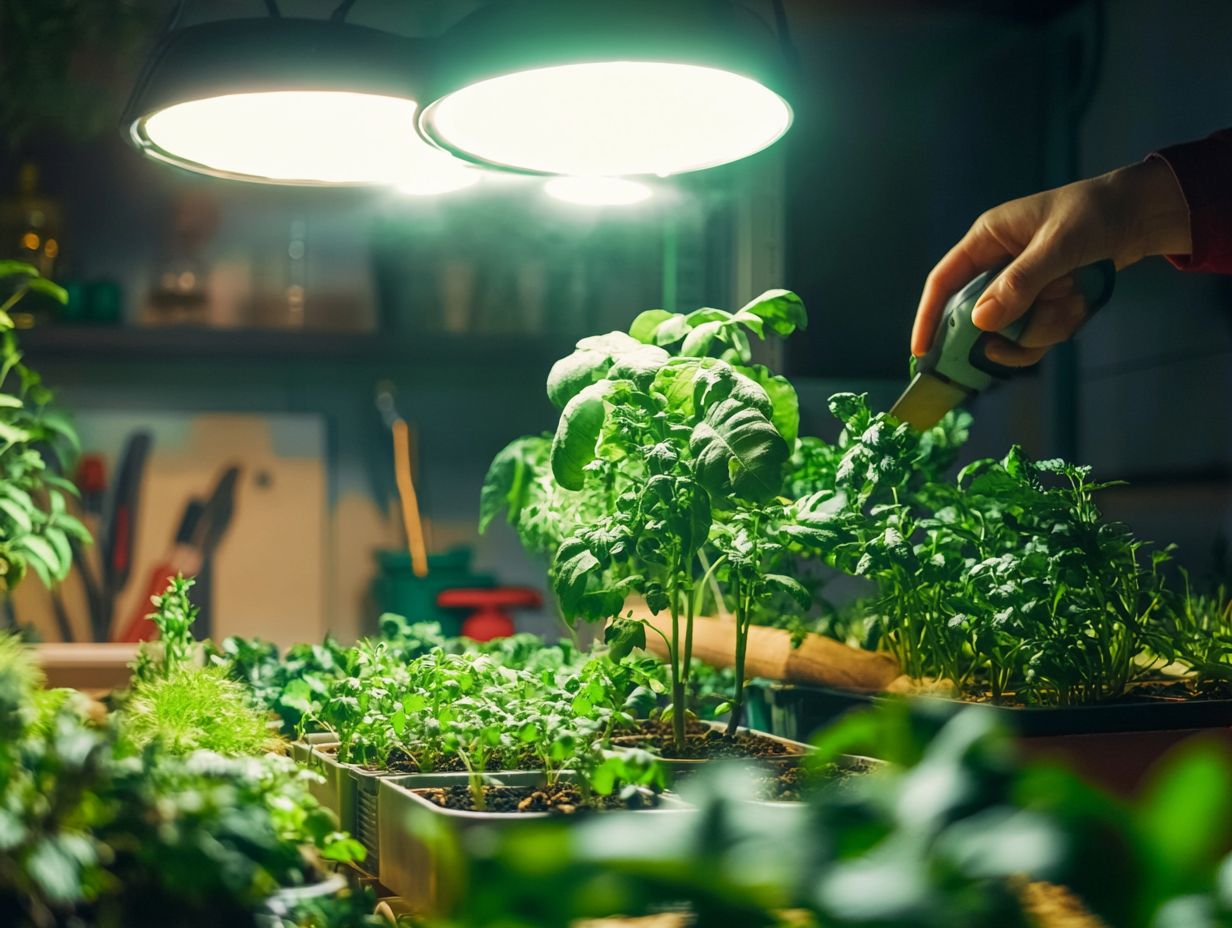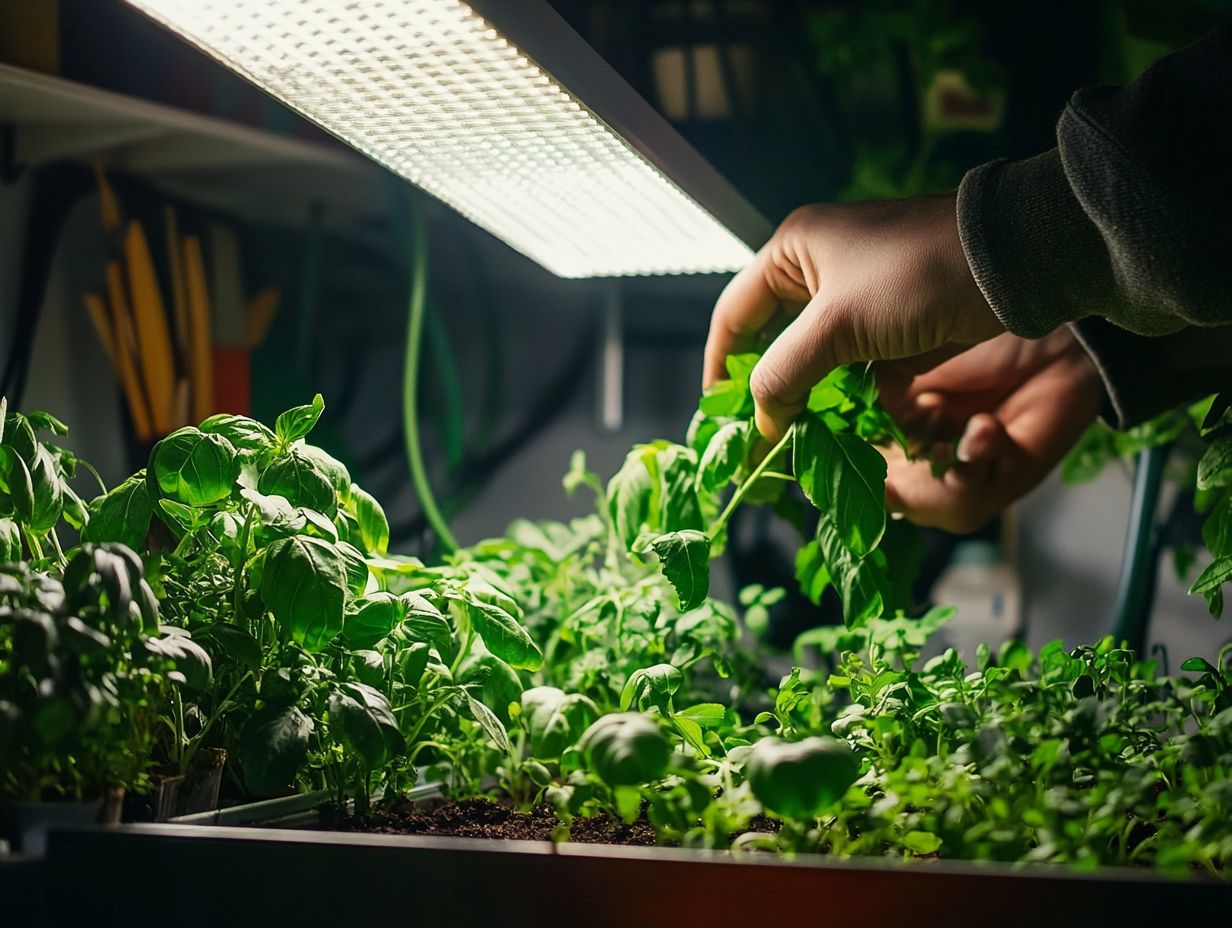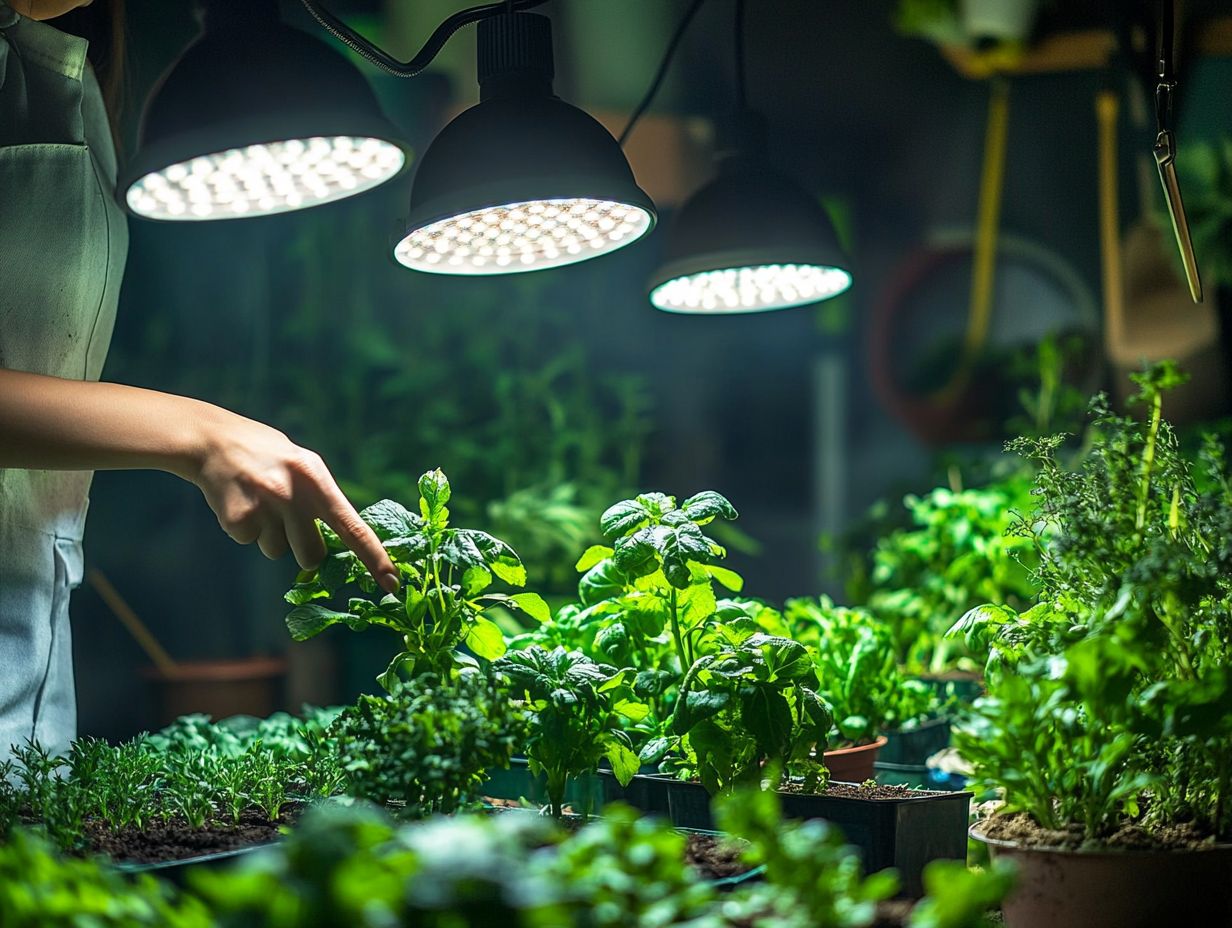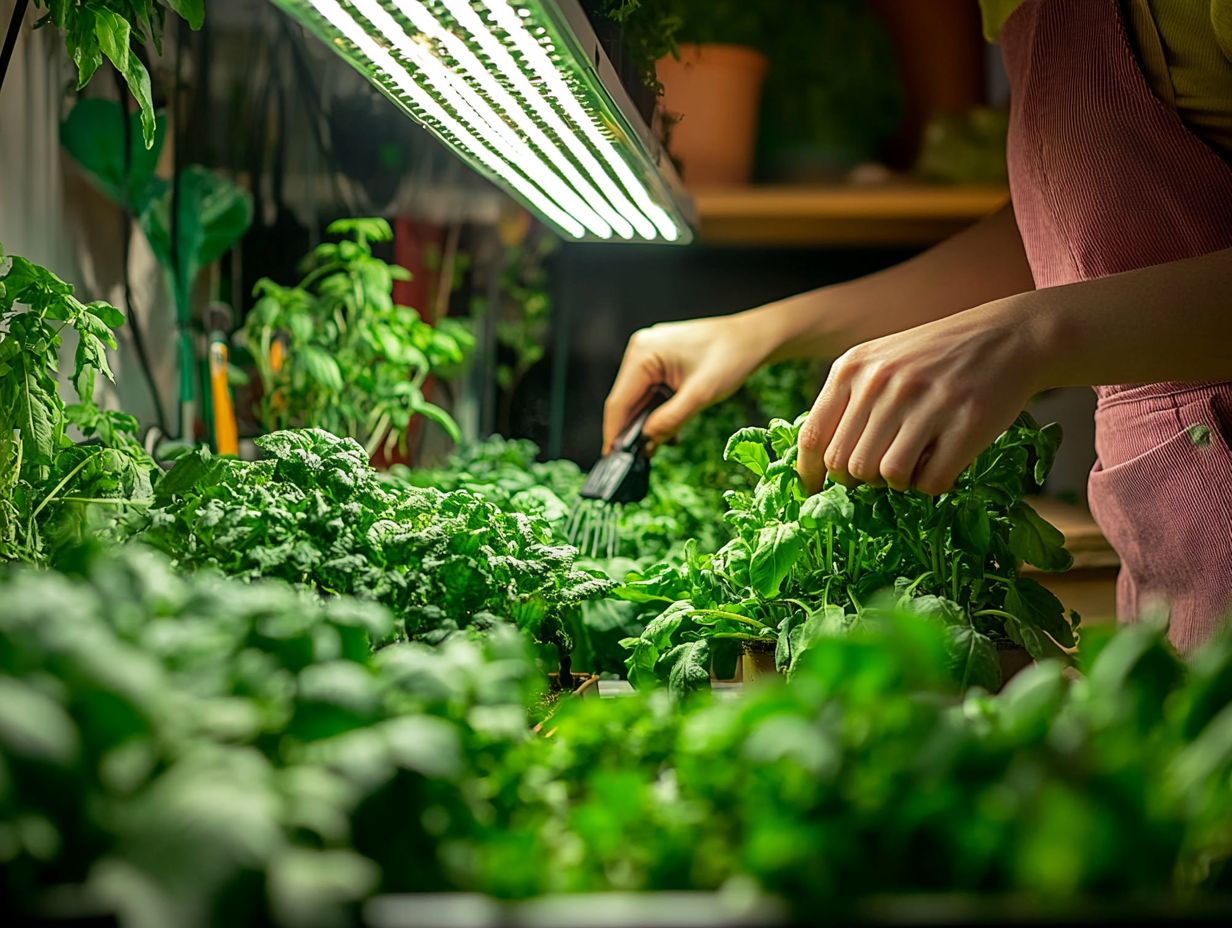Eco-Friendly Hiking: Top Trails for Nature Lovers
In today’s realm of indoor gardening, grow lights have emerged as indispensable allies for cultivating vibrant plants, no matter the season. Whether you re a seasoned gardener or embarking on your green journey, grasping the advantages of grow lights can truly elevate your gardening experience. From facilitating year-round growth to choosing the ideal type of light, this guide will provide you with all the insights you need. Discover how to optimize your setup, troubleshoot common challenges, and ensure your plants flourish under artificial light. Get ready to transform your indoor garden!
Contents
- Key Takeaways:
- Benefits of Using Grow Lights for Plants
- Types of Grow Lights
- Choosing the Right Grow Lights for Your Plants
- How to Set Up Grow Lights for Optimal Plant Growth
- Troubleshooting Common Issues with Grow Lights
- Frequently Asked Questions
- What are grow lights and why do plants need them?
- What type of grow light is best for my plants?
- How long should I leave grow lights on for my plants?
- Can I use regular household light bulbs as grow lights?
- How close should grow lights be to my plants?
- Do all plants require the same amount of light under grow lights?
Key Takeaways:

- Choose the right grow lights for your plants by considering factors such as light intensity, spectrum, and coverage area.
- Set up grow lights properly by placing them at the right distance and adjusting the duration of light exposure to prevent issues like light burn.
- Grow lights provide numerous benefits for plants, including increased growth and health, and the ability to grow year-round regardless of natural light availability.
What are Grow Lights?
What exactly are grow lights? Grow lights are your go-to artificial lighting systems, meticulously crafted to deliver the optimal light spectrum essential for plant health. They play a pivotal role in photosynthesis and overall growth, whether for indoor plants or outdoor gardening endeavors.
Grow lights mimic natural sunlight. They help houseplants, flowers, and indoor edibles thrive all year round. With an array of options at your disposal ranging from LED grow lights to full-spectrum bulbs you can cater to diverse plant needs, ensuring they stay vibrant and happy all year long.
By simulating the complete spectrum of sunlight, these systems foster robust growth, particularly in spaces where natural light is scarce. As an indoor gardener, you can choose specific grow lights tailored to the plants you nurture; for example, high-intensity discharge (HID) lights, which provide a powerful output suitable for larger plants, while compact fluorescent lights (CFLs) are ideal for seedlings and smaller herbs.
Selecting the right type of grow light can dramatically enhance flowering and fruiting, making them essential for anyone aiming for vibrant blooms or generous harvests. Understanding the variety of options available gives you the power to make informed choices that directly enhance your plants’ vitality and overall well-being.
Benefits of Using Grow Lights for Plants
The advantages of using grow lights for your plants are plentiful. They substantially boost health and growth by delivering customized light exposure tailored to the specific needs of various species, whether they are sun-loving houseplants or delicate seedlings. By mimicking natural sunlight, grow lights empower indoor gardening enthusiasts like you to extend the growing season, maintain proper light schedules, and guarantee that your plants receive the perfect light intensity and spectrum throughout the year.
Increased Growth and Health
The increased growth and health of your plants can be directly attributed to the effective use of grow lights. These lights provide the right intensity for photosynthesis, ensuring your plants receive the energy they need to thrive. By selecting the right light spectrum especially full-spectrum LED grow lights you can witness remarkable improvements in plant vitality and growth characteristics, creating an environment where your plants not only survive but truly flourish.
Light intensity plays a critical role in this process. Inadequate lighting can lead to slow growth and poor health. Remember, different plants have varying light requirements. Leafy greens like lettuce and spinach thrive under lower light conditions, while fruiting plants such as tomatoes and peppers demand more intense lighting. To learn more about these needs, check out our guide on how to use light for indoor vegetable gardens. The color temperature of the light, measured in Kelvin, can also influence flowering and fruiting cycles, with warmer lights around 3000K being ideal for promoting blooms.
Incorporating effective grow lights allows you, whether you’re a novice or an experienced gardener, to cultivate lush, vibrant plant life in any environment. For the best results, follow these tips for effective plant lighting to ensure your indoor garden thrives!
Year-Round Plant Growth
The ability to achieve year-round plant growth stands out as one of the most compelling advantages of using grow lights. These lights provide the supplemental illumination that compensates for natural fluctuations of sunlight throughout the seasons.
This is particularly beneficial for you as an indoor gardening enthusiast. It allows you to cultivate a diverse array of plants from indoor edibles to vibrant flowering varieties no matter the time of year.
By copying the sun’s natural light, grow lights give you the power to create optimal conditions for photosynthesis, which is how plants make their food using light. This ultimately results in healthier plants and vibrant colors.
This innovative technology invites you to rethink traditional gardening limitations. You can harvest fresh greens, fragrant herbs, and even delicate blooms when outdoor conditions are less than ideal.
Urban gardening is becoming more popular. More individuals like you are turning to these advanced light sources for consistent energy and support, fostering a more sustainable and self-sufficient lifestyle.
Automated systems enhance your gardening experience by giving you greater control over light cycles. This can lead to improved yields and a more fulfilling gardening adventure.
Types of Grow Lights

Grasping the nuances of the various types of grow lights is essential for effective indoor gardening. Each type presents distinct advantages designed to cater to the unique needs of different plants and environments.
From energy-efficient LED grow lights that provide a full spectrum of light to the tried-and-true fluorescent lights and the powerful high-intensity discharge (HID) options, understanding these differences gives you the power to choose the most fitting lighting systems for your indoor garden.
Comparison of LED, Fluorescent, and HID Lights
When comparing LED grow lights, fluorescent lights, and HID lights, it s vital to consider factors like energy efficiency, light spectrum, and overall plant care to pinpoint the best option for your indoor garden.
LED grow lights, especially full-spectrum varieties, are often lauded for their impressive energy efficiency and longevity. In contrast, fluorescent lights excel in the propagation and seed-starting phase, thanks to their budget-friendly initial cost.
HID lights offer high-intensity illumination ideal for flowering plants, but they have downsides, including higher energy consumption and increased heat output.
If you re growing tomatoes or peppers, you might appreciate the powerful light that HID systems provide. However, if your focus is on nurturing delicate herbs or seedlings, fluorescent options could be your best bet.
Each type serves unique needs, so understanding the specific requirements of your plants is essential for making an informed decision about the optimal lighting solution.
Choosing the Right Grow Lights for Your Plants
To choose the right grow lights, you need to understand your plants needs. Consider how factors such as light exposure, intensity, and optimal placement of grow lights influence plant growth.
Make sure to carefully check these factors as they can make all the difference! Different plants, from your beloved houseplants to high-intensity flowering varieties, have unique light needs that must be fulfilled for their optimal health and growth. Utilizing lighting tips for indoor herb gardens can help ensure your plants thrive.
Factors to Consider
When you’re selecting grow lights for your plants, several critical factors need your focus. You need to consider light requirements, intensity, and the ideal placement of those lights to ensure your plants receive the right energy for optimal growth. Understanding color temperature the type of light your plants receive, affecting growth and opting for energy-efficient solutions can significantly elevate your indoor gardening success.
Understanding the specific light needs of your plants is crucial, as different species have unique requirements, ranging from low to high light exposure. For example, leafy greens usually flourish under moderate light, while flowering plants need more light. Considering lighting considerations for plant growth is crucial, influencing not just photosynthesis but the overall health of your green companions.
Be mindful if you place the lights too close, you risk heat stress, but positioning them too far can stunt growth. The color temperature of your grow lights, measured in Kelvin, also plays an important part in plant development. To ensure your plants receive the right light, learn how to keep track of plant light needs. Cooler colors (around 6,500K) are perfect for vegetative growth, while warmer hues (around 3,000K) are ideal for encouraging flowering.
By thoughtfully considering these factors, you can optimize your indoor gardening setup, leading to healthier and more productive plants.
How to Set Up Grow Lights for Optimal Plant Growth
Setting up grow lights for optimal plant growth requires your careful attention to light duration, adjustments, and strategic placement. It s essential to create an environment that truly nurtures your plants.
By recognizing the unique light requirements of various species, you can customize your lighting setup, ensuring that each plant receives the ideal exposure it needs to thrive.
Proper Placement and Timing

The proper placement and timing of grow lights are crucial for your indoor gardening success. The correct distance and duration can dramatically influence the well-being and growth of your plants. By positioning your grow lights at the right height and adjusting them according to the growth stage of your plants, you can ensure they receive just the right amount of light exposure for optimal health.
For instance, seedlings generally prosper under lights placed about 2-4 inches above them, while mature plants might require the lights to be elevated to a distance of 12-24 inches to avoid leaf burn. Different species have distinct light requirements; leafy greens thrive with extended exposure, whereas flowering plants may benefit from a 12-hour light cycle. To ensure optimal growth, learn how to manage light for tropical plants.
By regularly monitoring the distance and duration, you can make timely adjustments and maximize energy absorption. Don t miss out on giving your indoor garden the best chance to flourish! Experiment with the height and settings until you find the perfect setup for your unique indoor garden.
Troubleshooting Common Issues with Grow Lights
Troubleshooting common issues with grow lights is an invaluable skill for any indoor gardener, ensuring that your plants receive the optimal lighting conditions necessary for thriving. Challenges like light burn and insufficient light exposure can significantly impede plant growth, so it s vital for you to identify symptoms early on.
By adjusting your grow light settings accordingly, you can maintain the health and vitality of your plants, setting the stage for a flourishing indoor garden.
Addressing Light Burn and Other Problems
Light burn and other grow light issues can harm your plants’ health. Too much high-intensity lighting can disrupt their growth.
Look for signs of light burn like yellowing leaves or stunted growth. Make adjustments to ensure your plants receive the right light.
Also, watch for crispy leaf edges and drooping foliage. These symptoms may indicate light stress.
Check the distance between your grow light and plants. If the light is too close, it can worsen the situation.
Observe how your plants respond to light changes. This will help you find the ideal distance and duration for growth.
Using a light meter enhances your precision. It measures the light intensity reaching your plants.
These tools allow you to make informed adjustments for a healthier growing environment.
Frequently Asked Questions
What are grow lights and why do plants need them?
Grow lights mimic sunlight for plants. They provide essential light for photosynthesis, helping plants grow when natural light is insufficient.
What type of grow light is best for my plants?

The best grow light depends on your plants’ needs. Common types include LED, fluorescent, and high-pressure sodium lights. LED lights are energy-efficient and provide a full spectrum of light. Fluorescent lights are affordable and great for leafy plants. High-pressure sodium lights excel for flowering and fruiting plants.
How long should I leave grow lights on for my plants?
Most plants need 12-16 hours of light per day. However, it’s crucial to research each plant’s specific light requirements for healthy growth.
Can I use regular household light bulbs as grow lights?
No, regular household bulbs lack the spectrum of light plants need. Grow lights balance red, blue, and white light essential for photosynthesis. Using regular bulbs can stunt plant growth.
How close should grow lights be to my plants?
The distance varies based on the type of light. LED lights can be closer, while high-pressure sodium lights should be further away to avoid burning. A good rule is to keep grow lights 12-18 inches away, but adjust based on plant growth.
Do all plants require the same amount of light under grow lights?
No, light needs differ among plants. For instance, succulents and cacti require less light. Research each plant s light needs to ensure optimal growth.






